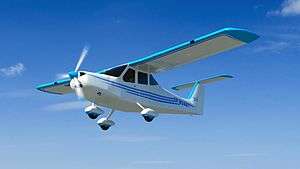Aero-Service Panda
| Panda | |
|---|---|
 | |
| Artist's rendering of the Panda | |
| Role | Ultralight aircraft |
| National origin | Poland |
| Manufacturer | Aero-Service Jacek Skopiński |
| First flight | 28 September 2016 |
| Status | In production (2016) |
| Unit cost |
€49,900 (Panda Standard, 2015) |
The Aero-Service Panda is a Polish ultralight, designed and produced by Aero-Service Jacek Skopiński of Warsaw. The aircraft is supplied complete and ready-to-fly.[1][2][3][4]
Design and development
The Panda was designed to comply with the Fédération Aéronautique Internationale microlight rules. It features a cantilever high-wing, a T-tail, a two-seats-in-side-by-side configuration enclosed cabin, fixed tricycle landing gear and a single engine in tractor configuration.[1][2][3][4]
The aircraft is made from sheet aluminum, with some parts, such as the engine cowling and wing tips made from composites. Its 8.91 m (29.2 ft) span wing employs a modified NACA 633-618 airfoil, has an area of 10.6 m2 (114 sq ft) and flaps. The cabin width is 120 cm (47 in).[1][2][3][4][5]
The Panda prototype was first flown on 28 September 2011.[2][3][4]
Operational history
Reviewer Marino Boric described the design in a 2015 review as possessing visibility that "is good in all directions because of very large glassed surfaces". He also noted that it is "sold at a reasonable price".[1]
Variants
- Panda Standard
- Base model powered by a 80 hp (60 kW) Rotax 912UL four-stroke powerplant.[1]
- Panda Sport
- Model powered by a 100 hp (75 kW) Rotax 912ULS four-stroke powerplant.[1]
- Panda Exclusive
- Model powered by a 100 hp (75 kW) Rotax 912ULS four-stroke powerplant plus with a Dynon glass cockpit and other options as standard.[1]
Specifications (Panda Standard)
Data from Tacke and manufacturer[1][5]
General characteristics
- Crew: one
- Capacity: one passenger
- Length: 6.62 m (21 ft 9 in)
- Wingspan: 8.91 m (29 ft 3 in)
- Height: 2.32 m (7 ft 7 in)
- Wing area: 10.6 m2 (114 sq ft)
- Airfoil: modified NACA 633-618
- Empty weight: 270 kg (595 lb)
- Gross weight: 472.5 kg (1,042 lb)
- Fuel capacity: 100 litres (22 imp gal; 26 US gal)
- Powerplant: 1 × Rotax 912UL four cylinder, liquid and air-cooled, four stroke aircraft engine, 60 kW (80 hp)
- Propellers: 3-bladed composite
Performance
- Maximum speed: 220 km/h (137 mph; 119 kn)
- Cruise speed: 190 km/h (118 mph; 103 kn)
- Stall speed: 62 km/h (39 mph; 33 kn) flaps down
- Never exceed speed: 260 km/h (162 mph; 140 kn)
- Range: 1,200 km (746 mi; 648 nmi) with 45 minutes reserves
- Service ceiling: 3,650 m (11,980 ft)
- g limits: +4/-2
- Rate of climb: 6 m/s (1,200 ft/min)
- Wing loading: 44.57 kg/m2 (9.13 lb/sq ft)
See also
References
- 1 2 3 4 5 6 7 8 Tacke, Willi; Marino Boric; et al: World Directory of Light Aviation 2015-16, page 20. Flying Pages Europe SARL, 2015. ISSN 1368-485X
- 1 2 3 4 Jackson, Paul (ed): Jane's All The World's Aircraft 2012-2013, pages 500-501. Jane's Information Group, 2012. ISBN 978 0 7106 30001
- 1 2 3 4 Jackson, Paul (ed): IHS-Jane's All The World's Aircraft 2013-2014, Development and Production, pages 502-504. Jane's Information Group, 2013. ISBN 978 0 7106 30407
- 1 2 3 4 Jackson, Paul (ed): IHS-Jane's All The World's Aircraft 2014-2015, Development and Production, pages 520-521. Jane's Information Group, 2014. ISBN 978-0710631350
- 1 2 Aero-Service Jacek Skopiński (2010). "Technical data and performance". Retrieved 17 December 2016.
External links
| Wikimedia Commons has media related to Skopiński Panda. |